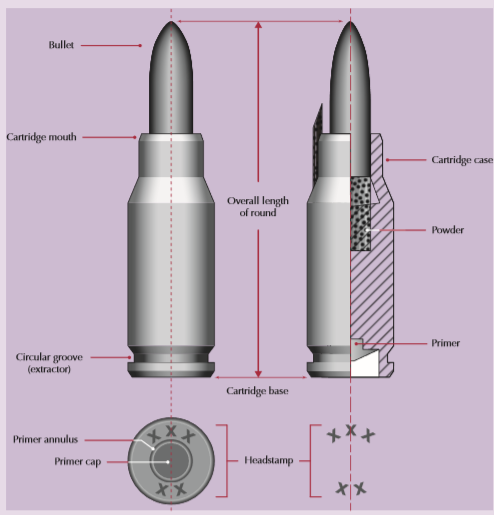A Biased View of Ammunition Pro Llc
A Biased View of Ammunition Pro Llc
Blog Article
Examine This Report about Ammunition Pro Llc
Table of ContentsThe Best Strategy To Use For Ammunition Pro LlcHow Ammunition Pro Llc can Save You Time, Stress, and Money.The 7-Minute Rule for Ammunition Pro LlcAmmunition Pro Llc Things To Know Before You Get ThisThe smart Trick of Ammunition Pro Llc That Nobody is Talking About
Most modern cartridges contain 4 primary components the case, guide, propellant, and projectile. A shotgun cartridge, even more typically referred to as a covering, is composed of 5 components the instance, primer, propellant, projectile(s) and wad. Allow's look at each part of a round, just how it functions, and alternatives that might be offered: The housing is the container, or real estate, right into which all the various other components fit.Technically, the increased use metals apart from brass have made this jargon incorrect, however, it continues to be a frequently utilized and accepted term. If you will certainly be reloading you need to stick with brass, brass alloy or plated brass. Pure very first run brass is best; however, recycled brass can be used also.
Various other types of brass, consisting of alloys or plated versions, can be utilized yet will have a much shorter lifetime. Early guns relied upon gunpowder, which is a specific combination of chemicals that burns swiftly and rapidly creates increasing gases as it sheds. Creating the ability to confine and control the burning process and gas expansion was the crucial to creating dependable, and risk-free, guns.
As a result of its instability gunpowder has been replaced by contemporary chemical compounds that achieve the exact same outcome without the threat. One of the most usual of these mixes is saltpeter, sulfur, and charcoal. The outcome is a propellant that sheds quick, is reliable and more stable. The propellant requires a smaller sized fee to be securely stiring up and this is achieved by the primer.
Little Known Facts About Ammunition Pro Llc.
As holds true with the propellant, gunpowder has actually been replaced by even more steady modern chemical substances in the building and construction of the primer. Quality guides are necessary to appropriate, reputable ammunition performance. A harmed or wet primer will certainly usually lead to failing to fire or a delayed, hang, fire scenario.
the bulletEvery gun calls for an object that will certainly be eliminated from the weapon which will, consequently, be used to hit the designated target. This item is called the projectile, although the terms bullet, slug or shot are usually utilized in its place. In truth rifles & handguns fire bullets while shotguns fire slugs or shot, the latter being made use of to explain a team of pellets expelled from a solitary shell or case.
Bullets, which is an acceptable term for the projectile for the majority of modern weapons, come in a range of types. Each is created for a different purpose and may or may not cycle effectively in every weapon.

Get This Report about Ammunition Pro Llc
As gone over previously, the situation is the housing right into which the various other elements are housed. When it comes to centerfire cartridges (the most common sort of modern ammunition) the primer is fitted into a pocket in the base of the instance, the propellant is loaded right into the hollow indoor room and a projectile (also known as bullet) is protected into the open end.
The firing pin, in turn, relocated rapidly ahead and strikes the guide. Once struck by the shooting pin the guide fires up and practically promptly stirs up the propellant by enabling a flame to enter the cartridge via a little opening behind the primer cap. This results in an instantaneous chemical reaction that develops broadening gases which, as a result of the restricted area within the case, create the projectile to be quickly gotten rid of.
Obviously, every firearm proprietor has an obligation to check out the proprietor's guidebook and method safe capturing. Before you understand it, you will be the one others involve for info, waiting patiently while you shoot so they can ask "Is it a bullet, ammo, or cartridge?".
The Only Guide to Ammunition Pro Llc

All are instances of self-supporting ammunition, which has been with us for well over a century. Utilizing these 4 components, ammo is either made by factories or handloaders, and though the cosmetics and design of the basic components have actually evolved and proceed to do so, their general function and just how they collaborate have not.
Cartridge cases are generally constructed from brass. They will hold the guide, gunpowder, and projectile. (Photo/Richard Mann)The cartridge case is what holds all self-contained ammo together. With rifle and hand gun ammo, the case is in some cases referred to as "brass." With shotguns, the instance is usually called a shell or a hull.
Indicators on Ammunition Pro Llc You Need To Know
Brass situations are reloadable, while steel instances are not. With shotgun hulls or shells, the base is constructed from brass for strength, and the remainder of the instance is made of plastic for economic situation. Shot coverings are additionally reloadable. Real Speed is now making rifle situations out plastics and steel, similar to shot shells.
With a lot of shotgun shells, extra details about the tons is published on the plastic section of the hull. Discount Ammo. Centerfire guides suit the cartridge or covering head, and when impacted by the firing pin they produce a trigger to begin the gunpowder melt. (Photo/Richard Mann)There are two kinds of priming methods used in contemporary, self-supporting ammo
Report this page